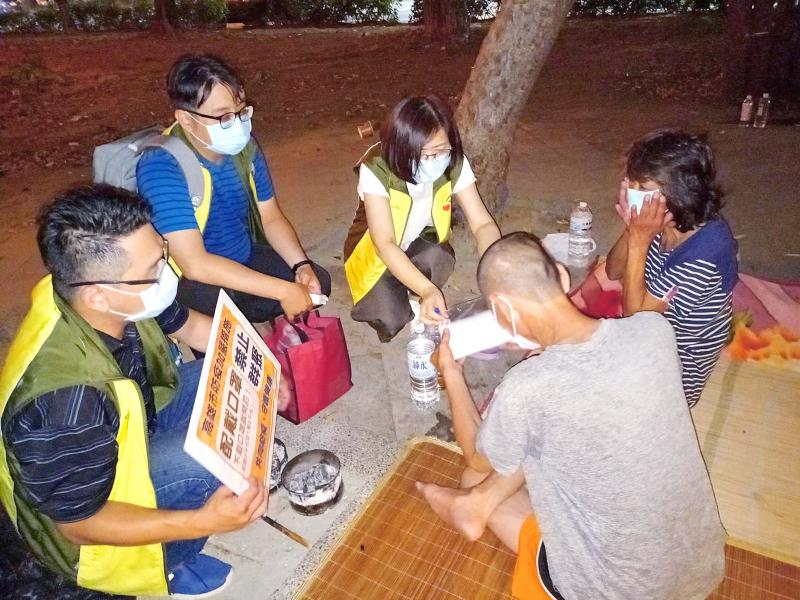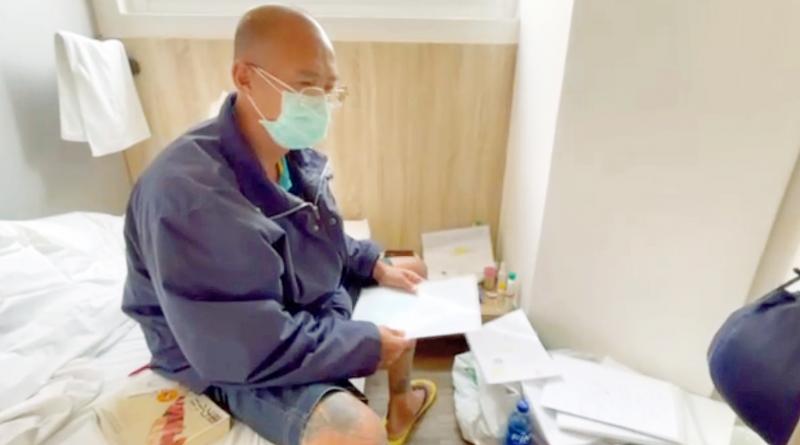With the COVID-19 outbreak heating up all over Taiwan, to prevent gatherings of homeless people from becoming a breach in the wall of disease prevention, social workers from Kaohsiung’s Social Affairs Bureau have been hastily going out every day to places where homeless people often sleep outdoors to hand out masks and remind people to wear masks and maintain social distancing.
The bureau said on Monday last week that social workers over the preceding few days had been making on-site visits to places where homeless people often sleep outside. They found that, with many public spaces having been closed off, there were only a few homeless people left in the hotspots where they often hang out, while others had gone off to rest in nearby nooks and corners.
A homeless man named “A-chen” said that he spends his time in a shady, cool corner of a park where not many people go. He said that he did not approach other people or go shopping, and that most people do not approach him either. He said that people steer clear of him, and although he only looks a little bit dirty, many people who catch sight of him act as if they had seen a virus.

Photo courtesy of Kaohsiung City Government’s Social Affairs Bureau 照片:高雄市政府社會局提供
For the duration of the outbreak, the Social Affairs Bureau, in addition to short-term placements at homeless people’s service centers, has also launched a system of short-term placements in contract hotels, and as of Monday last week, 42 of them have moved in. The Social Affairs Bureau will go on stepping up its efforts to urging homeless people to find a place to stay and visit them to make sure they are wearing masks and joining in the effort to fight the outbreak.
As soon as this news got out on Monday last week, many Internet users reposted it. Some people commented that Kaohsiung has taken preemptive measures by arranging places for homeless people to stay, and although they have been doing it quietly, everyone can see the efforts they have been making. Meanwhile, a civic group said that these measures are spot on, because if you let homeless people live somewhere comfortable, then they will not wander all over the place.
(Translated by Julian Clegg, Taipei Times)

Photo courtesy of Kaohsiung City Government’s Social Affairs Bureau 照片:高雄市政府社會局提供
全台武漢肺炎(新型冠狀病毒病,COVID-19)疫情升溫,為避免街友群聚成為防疫破口,高雄市社會局社工繃緊神經,每天到街友常露宿地點發放口罩,提醒配戴口罩、保持社交距離。
社會局上週一表示,近幾日社工實地查訪街友常露宿地點,發現隨著許多公共場域關閉,而這些街友經常出入的熱點也只剩零星幾位,其他則改到附近的角落休息。
一名街友阿真表示,自己都待在公園較少人會經過的陰涼角落,不會靠近別人,也不會去買東西,一般民眾也不會靠近他,大家都離得遠遠的,他只是看起來比較髒一點點,但很多人看到他像看到病毒一樣!
社會局在防疫期間,除了街友服務中心的短期收容安置,也啟動「合約旅館短期安置」機制,統計至上週一,已累計有四十二人入住,社會局會持續加強勸導街友安置及查訪配戴口罩,為抗疫一起努力。
上週一訊息一出,許多網友轉貼,指高雄市已超前部署安置遊民,默默地做,人民都看得到的!也有社福團體表示,這麼做真的很到位,讓街友住得舒適,就不會亂跑!
(自由時報記者方志賢)

In an effort to fight phone scams, British mobile phone company O2 has introduced Daisy, an AI designed to engage phone con artists in time-wasting conversations. Daisy is portrayed as a kindly British granny, exploiting scammers’ tendency to target the elderly. Her voice, based on a real grandmother’s for authenticity, adds to her credibility in the role. “O2” has distributed several dedicated phone numbers online to direct scammers to Daisy instead of actual customers. When Daisy receives a call, she translates the scammers’ spoken words into text and then responds to them accordingly through a text-to-speech system. Remarkably, Daisy

A: Isn’t the Met Gala, the Metropolitan Museum of Art’s fundraiser, chaired by Vogue editor-in-chief Anna Wintour? B: Yeah, the blockbuster “The Devil Wears Prada” is allegedly based on her story. A: This year’s four co-chairs are actor Colman Domingo, F1 driver Lewis Hamilton, rapper A$AP Rocky and Louis Vuitton men’s creative director Pharrell Williams. B: And basketball superstar LeBron James is the honorary chair. A: I can’t wait to see the lineup of stars on the red carpet. A: 大都會博物館慈善晚宴「Met Gala」,是《時尚》雜誌全球總監安娜溫圖為該館服裝學院主辦的募款活動吧? B: 對啊,電影《穿著普拉達的惡魔》據說是以她為範本。 A: 今年晚宴共同主席還有:演員柯爾曼多明哥、F1賽車手路易斯漢米頓、饒舌歌手A$AP洛基、LV男裝創意總監菲董。 B: 籃球巨星勒布朗詹姆斯則是榮譽主席。 A: 紅毯上的全球星光真令人期待! (By Eddy Chang, Taipei Times/台北時報張迪)

Bilingual Story is a fictionalized account. 雙語故事部分內容純屬虛構。 Emma had reviewed 41 resumes that morning. While the ATS screened out 288 unqualified, she screened for AI slop. She could spot it a mile away. She muttered AI buzzwords like curses under her breath. “Team player.” “Results-driven.” “Stakeholder alignment.” “Leveraging core competencies.” Each resume reeked of AI modeling: a cemetery of cliches, tombstones of personality. AI wasn’t just changing hiring. It was draining the humanity from it. Then she found it: a plain PDF cover letter. No template. No design flourishes. The first line read: “I once tried to automate my

1. 他走出門,左右看一下,就過了馬路。 ˇ He walked outside, looked left and right, and crossed the road. χ He walked outside and looked left and right, crossed the road. 註︰並列連接詞 and 在這句中連接三個述語。一般的結構是 x, y, and z。x and y and z 是加強語氣的結構,x and y, z 則不可以。 2. 他們知道自己的弱點以及如何趕上其他競爭者。 ˇ They saw where their weak points lay and how they could catch up with the other competitors. χ They saw where their weak points lay and how to catch up with the other competitors. 註:and 一般連接同等成分,結構相等的單詞、片語或子句。誤句中 and 的前面是子句,後面是不定詞片語,不能用 and 連接,必須把不定詞片語改為子句,and 前後的結構才相等。 3. 她坐上計程車,直接到機場。 ˇ She took a cab, which took her straight to the airport. ˇ She took a cab and it took her straight